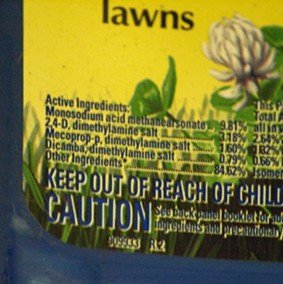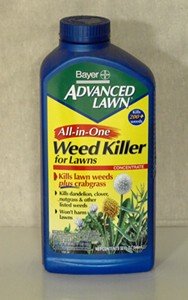Types of Herbicides
Classification and Trade Names
Systemic and Contact Types of Herbicides
The different types of herbicides are all designed to kill plant tissue. However, they accomplish it by two basic methods. They are known as Contact Herbicides and Systemic Herbicides.
Contact herbicides: Contact is a word that means the chemical in that specific type of herbicide will kill the parts of the plant it contacts. For broadleaf weeds this means it will kill the above ground leafy part of the plants. It will not directly kill the below ground plants parts, such as roots, bulbs, tubers, or rhizomes.
Contact herbicides are popular because they work quickly by killing the tissue in as fast as one day. Some herbicides will combine contact with systemic chemicals for a faster effect. New RoundUp Weed and Grass Killer has combined both for faster control. Others have done the same.
For some plants, killing the above ground portions will not be enough to wipe out the plant completely. Most plants will regrow plant tissue and the herbicide will need to be reapplied. However, each time the plant has to use energy to start growth again will weaken the plant and eventually kill it.
Systemic Herbicides: For systemic types of herbicides, the word "Systemic" means the plant absorbs through the leaves or stems and transports it internally throughout the plant. The chemical travels with the sap so it usually doesn't have the quick "knockdown" effect.
The greatest benefit of a systemic type of herbicide is that it will kill the entire plant, roots and all. The speed of chemical movement in the plant is largely dependent on soil and air temperature. A chemical sprayed in early spring may take a couple weeks longer to work than the same chemical sprayed in mid-summer. The speed of kill is also dependent on the "mode of action" of the chemical (how the chemical works inside the plant).
Click on the links for more information on the various Organic Types of Herbicides and Non-organic Chemical Herbicides. So far there are very few organic herbicides. The vast majority of pesticides, including herbicides, are of the chemical types.
Mode of Action
The herbicide mode of action is a term describing what the chemical does inside the plant. There is a mode of action for every type of chemical. The mode of action is the way the chemical controls or kills the weeds. One chemical may prevent the metabolism of sugars in plants, while another may inhibit the development of an essential hormone.
While it is a complex science, it is something that can be helpful to learn. It is especially important for fungicides and insecticides. For example, grass diseases can easily become resistant to a specific fungicide. By alternating fungicides with different modes of action, there is a much less chance of developing a resistance. It is the same for some insecticides.
Chemical Names and Trade Names

You will find the "chemical name" on the front of the label under the list of ingredients. The chemical name never changes and distinguishes one chemical from another. They may be listed under "active ingredients".
The "trade name" is the name a manufacturer gives a product or combination of chemicals that make up a product. Different manufacturers can use the same chemicals, but will often give the product a different trade names in a effort to establish a brand. What you may want to look for is the percentage of chemical in the product. For those concerned about chemical use, look for a product with the least amount of chemical that offers effective control.
Pesticide Label: The label is a legal document between the EPA, manufacturer, and the consumer. By law, every type of herbicide and every other type of pesticide must have a label intact. It should be read completely and carefully before opening the container. If the label is unreadable or if torn, you can usually find it online.
The label on various types of herbicides and other pesticides will list the weeds or insects it will control, dilution rates if any, and personal protective equipment that must be worn, reentry times, as well as other information. Remember, you legally cannot wear less equipment than stated on the label, but you can always wear more. Always be safe.
Please read our chemical safety page for more information on Using Pesticides Safely.
Organic Herbicides
Not all herbicides are the same. Organic herbicides are becoming more popular, but the choices are still limited. Find out what products are popular and how they work.
Understanding Chemical Herbicides
Some weeds are difficult to control. Chemical herbicides offer a safe and effective solution when used wisely and according to the label. Find out how they work and what products are available.
Effects of Pesticides on the Environment
We all need to be aware of our environment. If you would like some helpful information on how pesticides can effect the environment, click on the link above.
Using Spray Adjuvants to Increase Pesticide Effectiveness
Spray Adjuvants are added to herbicides to increase their safety and effectiveness. Find out how adding a sticker and spreader to your herbicide can help it to work better while using less product.
Zoysia Grass and 2,4-D Concerns
If you have a zoysia grass lawn, you know how beautiful and hardy it is. However, 2,4-D herbicide can harm it during a short period in spring. Click here to learn about weed control for zoysia lawns.
Types of Herbicides to Lawn Care Academy Home




